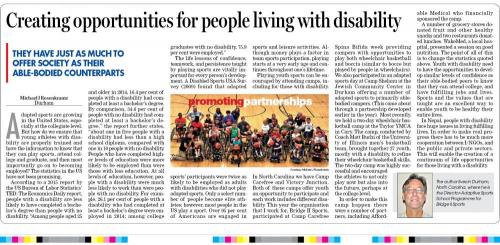
Adapted sports are growing in the United States, especially at the collegiate level. But how do we ensure that young athletes with disability are properly trained and have the information to know that they can play sports, attend college and graduate, and then most importantly go on to becoming employed? The statistics in the US have not been promising.
“People with a disability are less likely to have completed a bachelor's degree than people with no disability. Among people age 25 and older in 2014, 16.4 percent of people with a disability had completed at least a bachelor’s degree. By comparison, 34.6 percent of people with no disability had completed at least a bachelor’s degree. About 1 in 5 people with a disability had less than a high school diploma, compared with 1 in 10 people with no disability. People who have completed higher levels of education were more likely to be employed than were those with less education. At all levels of education, however, people with a disability were much less likely to work than were people with no disability. For example, 26.1 percent of people with a disability who had completed at least a bachelor’s degree were employed in 2014; among college graduates with no disability, 75.9 percent were employed.” (https://www.bls.gov/opub/ted/2015/people-with-a-disability-less-likely-to-have-completed-a-bachelors-degree.htm)
The life lessons of confidence, teamwork, and persistence taught by playing sports are vitally important for every person’s development. A Disabled Sports USA survey (2009) found that adapted sports participants were twice as likely to be employed as adults with disabilities who did not play adapted sports.
Only a select number of people become elite athletes; however, most people in the US play a sport. Over 95% of Americans are engaged in sports and leisure activities. Although money plays a factor in team sports participation, playing starts at a very early age and continues throughout one’s lifetime.
Playing youth sports can be encouraged by attending camps, including for those with disability. In North Carolina we have Camp Carefree and Victory Junction. Both of these camps offer youth an opportunity to participate and each work includes different disability. This year the organization that I work for, Bridge II Sports, participated at Camp Carefree Spina Bifida week providing campers with opportunities to play both wheelchair basketball and boccia (similar to bocce but played by people in wheelchairs). We also participated in an adapted sports day at Camp Shelanu at the Jewish Community Center in Durham offering a number of adapted sports to primarily able-bodied campers. (This came about through a partnership developed earlier in the year).
Most recently, we held a two day wheelchair basketball camp at the Taylor YMCA in Cary. The camp, conducted by Coach Matt Buchi of the University of Illinois men’s basketball team, brought together 27 youth, mostly with a disability, to refine their wheelchair basketball skills. The two-day camp was highly successful and encouraged the athletes to not only play now but also into the future, perhaps at the college level.
In order to make this camp happen there were a number of partners, including Affordable Medical who financially sponsored the camp. A number of grocery stores donated fruit and other healthy snacks and two restaurants donated lunches. WakeMed, a local hospital, presented a session on good nutrition. The Director of BIIS presented a session about incontinence to parents.
The point of all of this is to change the statistics quoted above. Youth with disability need to have the opportunities to develop similar levels of confidence as their able-bodied peers to know that they can attend college, and have fulfilling jobs and lives. Sports and the values that are taught are an excellent way to enable youth to be healthy their entire lives.
In Nepal, people with disability face huge issues in living fulfilling lives. There are only a few organizations (e.g. ENGAGE and NSCISA) that provide opportunities to play adaptive sports. In order to make real progress there has to be much more cooperation between I/NGOs, and the public and private sectors. This will enable the creation of a continuum of life opportunities for those living with a disability. People with a disability have just as much to offer society as their able-bodied counterparts. This can start with all youth, no matter what their situation, being provided with opportunities to play sports.










Add new comment